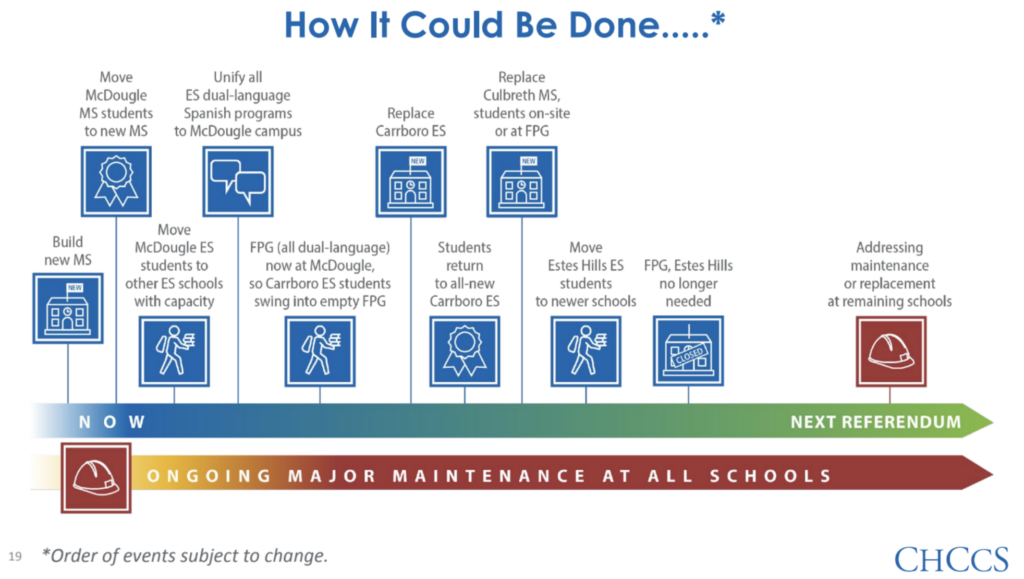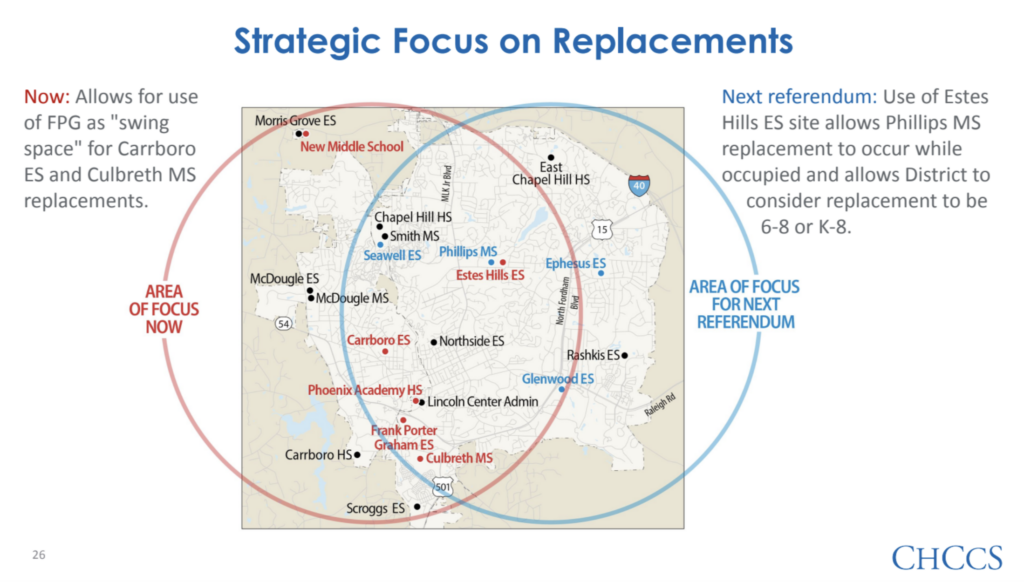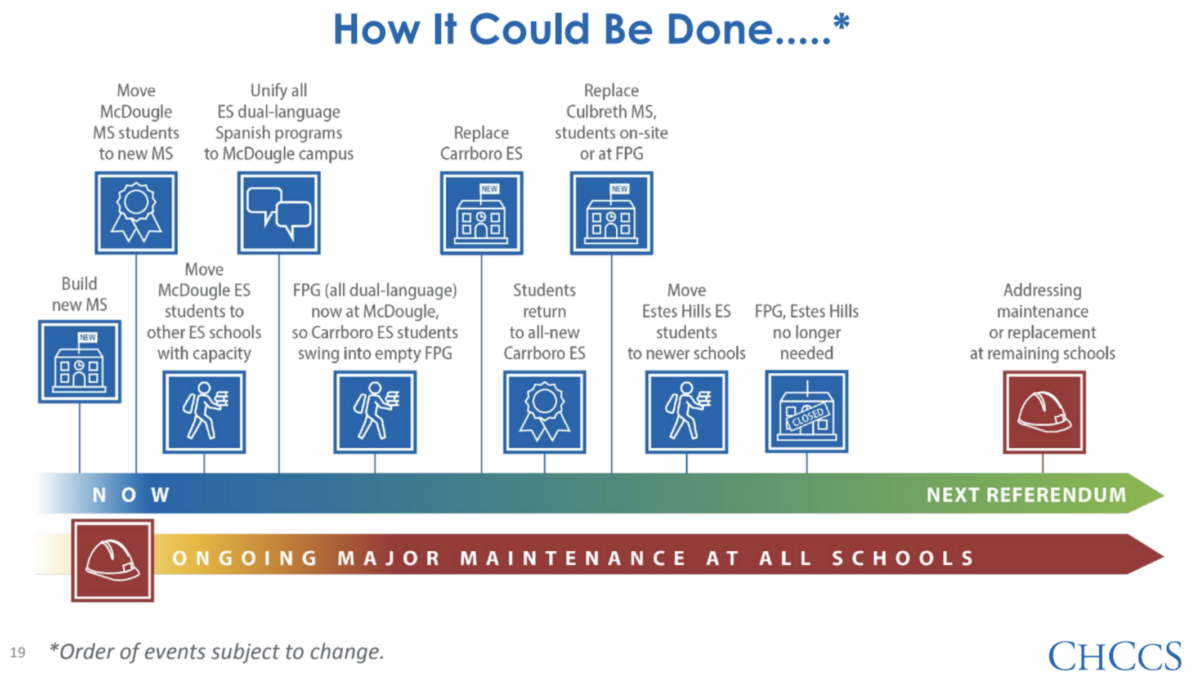This post focuses on the Chapel Hill-Carrboro City Schools, but it’s important to note that the planned bond will help meet the needs of both the Chapel Hill-Carrboro City Schools and the Orange County Schools. (The $300 million bond money and $100Million pay-go money will be split between CHCCS and OCS.)
Last night, the Chapel Hill Carrboro City School Board of Education approved the project plan for one of the most significant investments in our school system in years—a $300 million school bond, which will be accompanied by more than a hundred million dollars of additional funding, that will go on the ballot this fall.
Already, we’re hearing a lot of confusion circulating around this plan. Here’s a few things to keep in mind:
These capital improvements are long overdue and this discussion has gone on for a long time
We’re lucky: in the past several years, several former school board members have joined the Orange County Board of Commissioners – and they have continued to advocate for our schools. These discussions have been going on for years.

A short history: Many folks do not realize that Orange County has two school systems, or that by law the county commissioners are mandated responsibility for school facilities. Both school districts have passed resolutions in support of the bond.
In 2013/14, the school board issued a school facilities report, which recommended bonds to repair and reconstruct our aging and inadequate school facilities. A first bond passed in 2016, which allowed for repairs to Chapel Hill High School. At the same time, the school board and county commissioners recognized that additional phases of work would be needed to address the many other aging buildings in our school district.
In Fall 2021, county commissioner Jean Hamilton petitioned the commission to form a Capital Needs Work Group, which she chaired and included representatives from both school systems. The committee found that many of the county’s 32 school buildings were outdated, providing “sub-optimal learning environments.”
In September 2022, the committee recommended hiring a consultant to determine the full extent of the county’s needs and make recommendations for how to address them. In March 2023, the BOCC selected a consultant to assess the school facility needs in the county. In December, the consultant presented their findings.
In January, the BOCC discussed how and whether to pay to fix our schools. Because the county tends to think in terms of a ten-year budgeting window, they focused on the first decade of the scenarios outlined, which lowered the amount they need to raise. (For the seventy-page presentation, see here).
In February, the Boards of Education adopted the bond resolution for the BOCC and the BOCC adopted the resolution for a November 2024 bond this past April. Last Tuesday, the bond plan was discussed in great detail at the CHCCS school board’s Finance, Facilities, and Operations (FFO) meeting, and a bit last night. (They needed to approve the project plan.)
The CHCCS school board will hear a full presentation on June 6. Other important dates:
May 21: The school boards present their plans/project sequencing to the BOCC. The BOCC is likely to adopt project based oversight and there needs to be some flexibility for unexpected events, so there will likely be changes across the decade as they proceed with the school facilities plan. (Sometimes a major system will break out of the expected order and have to be addressed.)
May 29: Apply for the School Bond Education Committee
June 4: The Board of County Commissioners holds a public hearing on the bond referendum
June 18: The BOCC will adopt the bond order, formally set the ballot question
November 5: Election Day.
Some of our school buildings are in really bad shape

In January, parents, teachers, and other school staff wrote to the commissioners, sharing information about the current state of our schools. In her letter, Carrboro Elementary School principal Jennifer Halsey noted the following:
Unfortunately, we face challenges each day with the conditions of our building. Our maintenance department is here almost daily fixing leaks, broken doors, hvac, pests due to cracks and holes in the exterior, mold, etc. Safety is a major concern. These issues interfere with our ability to provide the best possible learning environment for our students.
Another parent observed that these maintenance problems are found throughout the district, suggesting the dire need for investment:
I have/have had children at Carrboro Elementary, Seawell Elementary, and Smith middle and all of the buildings have major issues. At Seawell, the teachers in the outward “pod” buildings routinely have to place sandbags in front of their classroom doors when it rains and it still often floods. At Carrboro, there has been no money to fix the lights over the playground area that after-school uses. The solution has been that the custodians leave the classroom lights on for the rooms that border that area in hopes that it allows some lights on the outside walk-way areas. This is extremely inefficient and obviously a safety hazard. I have heard of many roof leaks over the years in various classrooms at all schools. My daughter’s science classroom at Smith middle has obvious water damage on the ceiling tiles and mold growth.
Jamezetta Bedford, the chair of the BOCC, wrote to us and said this: “The buildings are not only beyond their useful life spans, they are educationally inadequate. In the 1950s and 1960s schools built did not have spaces for EC classrooms, small group classrooms, speech or occupational therapist offices, therapy space, wiring for tech, teacher offices, afterschool space, preK space, etc. Safety was not a concern so the older campuses have several buildings or bathrooms accessed by going outside. Classrooms were sized to only sitting in rows of desks without table areas for group and project work. Staff restrooms were very limited in number up through the early 2000s at a couple of CHCCS schools. These renovations allow sustainable features to be added more quickly that will be paid back in energy cost savings as well.”
Our enrollment patterns are uneven
Elementary school demand had dropped precipitously, for a variety of reasons – people are having fewer children, Orange County’s population growth is taking place in older age cohorts, private and charter school enrollment is growing, and some parents are homeschooling.
Meanwhile, our middle school enrollments are more stable, and our high school enrollments are growing. (The fall in school enrollments is a nationwide problem, and it’s worse in places with high housing prices, like Chapel Hill and Carrboro).
Given the paucity of state funding, our school system has to be judicious in how it spends money. While many of our schools are at or near capacity, others are severely under enrolled. As recently as 2003, Estes Hills had an enrollment of 549 students. This year, it has only 350 students enrolled, a 36 percent decrease. Northside and Ephesus are also enrolling far below their capacity.
The plan allows CHCCS to upgrade its schools while minimizing disruption

The school buildings in need of replacement—Carrboro Elementary, Culbreth Middle School, Frank Porter Graham, Estes Hills—are in bad shape. It would cost more money, and take more time, to renovate them than it would to replace them.
And, because of declining enrollments at the elementary school we have the opportunity to minimize disruption to the educational environment while still getting the new schools we desperately need.
If the bond is passed, the plan is as follows:
1. Build a new middle school next to Morris Grove Elementary. (opening in 2026)
2. Move McDougle Middle School students the new middle school, move McDougle Elementary students to other schools with capacity.
3. Consolidate our elementary dual-language programs at McDougle, which will make it easier to serve students in this high-demand program.
4. Build a new Carrboro elementary school. For one year, Carrboro students will attend FPG, which currently houses a dual-language school. (New school opening in 2031)
5. Build a new Culbreth Middle School, with students moving to FPG for one year. (New school opening in 2033).
6. Estes Hills students move to schools with extra capacity. Site reserved for a future school building (either elementary or middle, depending on demand) or, potentially, housing for teachers (which we’d really love to see).

This is a thoughtful plan that gets us three new schools in a decade, and also allows us to make investments in other school buildings as needed. For several years, elected officials—school board members and county commissioners—have been working on a plan that addresses our needs for new school buildings, and we’re excited that they have prioritized our aging schools. Many of these schools were built 60-70 years ago, and have reached the end of their useful lifespans. We shouldn’t expect our teachers and students to work and learn in substandard conditions.
It opens up the possibility of having land for teacher housing
Land is at a premium in our area, and teachers commute from far away to teach in our district. Our hope is that this process would open up dedicated land for teacher housing. An example of this is in Buncombe County, which has subsidized housing for teachers in their school district. The campus is at full occupancy, and is used as a recruiting tool for the district in bringing talented teachers to their region.

